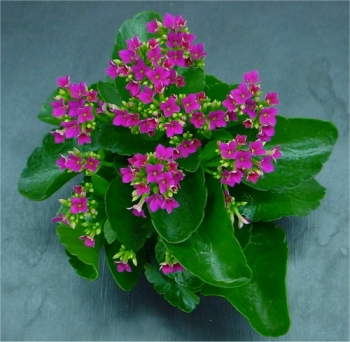- Kalanchoe
Taxobox
name = Kalanchoe

image_width = 204px
image_caption = "Kalanchoe blossfeldiana "
regnum =Plant ae
divisio = Magnoliophyta
classis =Magnoliopsida
ordo =Saxifragales
familia =Crassulaceae
genus = "Kalanchoe"
genus_authority = Adans.
subdivision_ranks = Species
subdivision = Around 125, see text.
synonyms = "Bryophyllum""Kalanchoe" is a genus of about 125 species of
tropical , succulentflowering plant s in the FamilyCrassulaceae , mainly native to theOld World but with a few species now growing wild in theNew World following introduction.Most are
shrub s or perennialherbaceous plants, but a few are annual or biennial. The largest, "Kalanchoe beharensis " fromMadagascar , can reach 6 m tall, but most species are less than 1 m tall.Members of Kalanchoe genus are characterized by opening their flowers by growing new cells on the inner surface of the
petal s to force them outwards, and on the outside of the petals to close them.The genus was first described by the botanist
Michel Adanson in 1763. Reportedly, the name came "from the Chinese name for one of the species." Citation|title=Kalanchoe: The Genus and its Chromosomes| url=http://links.jstor.org/sici?sici=0002-9122(193810)25:8%3C572:KTGAIC%3E2.0.CO;2-A| doi=10.2307/2436516|first=J. T.| last=Baldwin Jr.| journal=American Journal of Botany| page=572-579| volume=25| issue=8| date=October 1938| accessdate=2007-11-28 ] This Chinese species is thought to have been either "Kalanchoe ceratophylla " or "Kalanchoe spathulata ".Fact|date=November 2007 The genus "Bryophyllum" was described by Salisbury in 1806 and the genus "Kitchingia" was created by Baker in 1881. Kitchingia is now regarded as a synonym for Kalanchoe, whereas some botanists treat Bryophyllum as a separate genus.Cultivation and uses
These plants are cultivated as ornamental houseplants and rock or "succulent" garden plants. They are popular because of their ease of propagation, low water requirements, and wide variety of flower colors typically borne in clusters well above the vegetative growth. The section "
Bryophyllum " - formerly an independent genus - contains species such as the "Air plant" "Kalanchoe pinnata ". In these plants, new individuals develop vegetatively as plantlets, also known as bulbils or gemmae, at indents along the leaves. These young plants eventually drop off and take root. No males have been found of one species of this genus which does flower and produce seeds, and it is commonly called, the "Mother of Thousands".Diseases
Toxicity and traditional medicine
In common with other Crassulaceae (such as the genera
Tylecodon , Cotyledon andAdromischus ), some "Kalanchoe" species containbufadienolide cardiac glycosides [ cite web
last = Steyn
first = Pieter S
coauthor = van Heerden, Fanie R.
title = Bufadienolides of plant and animal origin
publisher = Royal Society of Chemistry
work = Natural Product Reports
date =1998
url = http://www.rsc.org/delivery/_ArticleLinking/DisplayArticleForFree.cfm?doi=a815397y
accessdate = 2007-09-19] which can cause cardiacpoisoning , particularly in grazing animals. [ cite web
last = McKenzie
first = RA
coauthor = Dunster PJ.
title = Hearts and flowers: Bryophyllum poisoning of cattle.
work = Aust Vet J.
month = July | year = 1986
url = PMID 3778371
accessdate = 2007-09-19] [ cite web
last = McKenzie
first = RA
coauthor = Franke FP, Dunster PJ.
title = The toxicity to cattle and bufadienolide content of six Bryophyllum species.
work = Aust Vet J.
month = October | year = 1987
url = PMID 3439945
accessdate = 2007-09-19] This is a particular problem in the native range of many Kalanchoe species in theKarroo region of South Africa, where the resulting animal disease is known askrimpsiekte (shrinking disease) or ascotyledonosis . [ cite web
last = Hilton-Taylor
first = Craig
title = How Dangerous are Euphorbias? (And Others in the Family Euphorbiaceae) with some comments on dangerous plants in the families Agavaceae, Aizoaceae, Apocynaceae, Compositae, Crassulaceae, Liliaceae
url = http://www.theamateursdigest.com/epoisons.htm
accessdate = 2007-09-19] Similar poisonings have also occurred in Australia.In traditional medicine, "Kalanchoe" species have been used to treat ailments such as infections, rheumatism and inflammation. "Kalanchoe" extracts also have immunosuppressive effects. "
Kalanchoe pinnata " has been recorded in Trinidad and Tobago as being used as a traditional treatment for hypertension. [ cite web
last = Lans
first = CA
title = Ethnomedicines used in Trinidad and Tobago for urinary problems and diabetes mellitus.
work = J Ethnobiol Ethnomed.
date =2006-10-13
url = PMID 17040567
accessdate = 2007-09-19]A variety of bufadienolide compounds have been isolated from various "Kalanchoe" species. Five different bufadienolides have been isolated from "
Kalanchoe daigremontiana ". [ cite web
last = Wagner
first = H
coauthors = Fischer M, Lotter H
title = Isolation and Structure Determination of Daigremontianin, a Novel Bufadienolide from "Kalanchoe daigremontiana".
work = Planta Med.
month = April | year = 1985
url = PMID 17340448
accessdate = 2007-09-19] [ cite web
last = Supratman
first = U
coauthors = Fujita T, Akiyama K, Hayashi H
title = Insecticidal compounds from "Kalanchoe daigremontiana x tubiflora".
work = Phytochemistry
month = September | year = 2001
url = PMID 11551556
accessdate = 2007-09-19] Two of these,daigremontianin andbersaldegenin 1,3,5-orthoacetate , have been shown to have a pronouncedsedative effect. They also have the strong positiveinotropic effect associated with cardiac glycosides, and with greater doses an increasing effect on thecentral nervous system .Bufadienolide compounds isolated from "
Kalanchoe pinnata " includebryophillin A which showed strong anti-tumor promoting activity, andbersaldegenin-3-acetate andbryophillin C which were less active. [ cite web
last = Supratman
first = U
coauthors = Fujita T, Akiyama K, Hayashi H, Murakami A, Sakai H, Koshimizu K, Ohigashi H
title = Anti-tumor promoting activity of bufadienolides from "Kalanchoe pinnata" and "K. daigremontiana x tubiflora".
work = Biosci Biotechnol Biochem.
month = April | year = 2001
url = PMID 11388478
accessdate = 2007-09-19] Bryophillin C also showed insecticidal properties. [ cite web
last = Supratman
first = U
coauthors = Fujita T, Akiyama K, Hayashi H
title = New insecticidal bufadienolide, bryophyllin C, from "Kalanchoe pinnata".
work = Biosci Biotechnol Biochem.
month = June | year = 2000
url = PMID 10923811
accessdate = 2007-09-19]elected species
References
Wikimedia Foundation. 2010.
